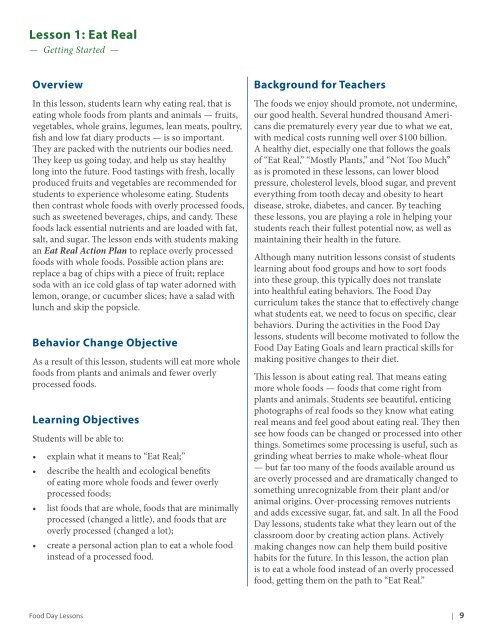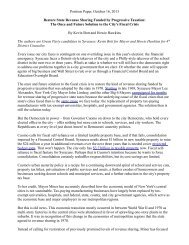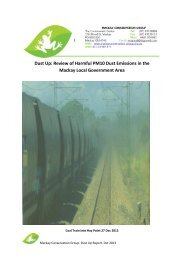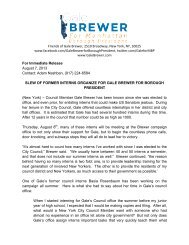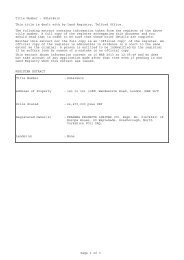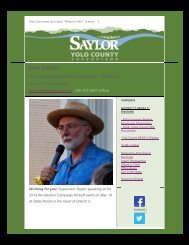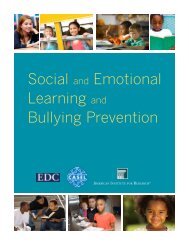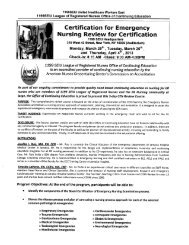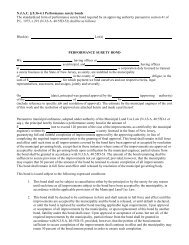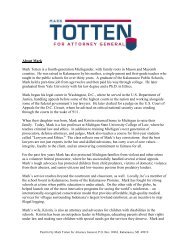2012 Food Day School Curriculum
2012 Food Day School Curriculum
2012 Food Day School Curriculum
Create successful ePaper yourself
Turn your PDF publications into a flip-book with our unique Google optimized e-Paper software.
Lesson 1: Eat Real— Getting Started —OverviewIn this lesson, students learn why eating real, that iseating whole foods from plants and animals — fruits,vegetables, whole grains, legumes, lean meats, poultry,fish and low fat diary products — is so important.They are packed with the nutrients our bodies need.They keep us going today, and help us stay healthylong into the future. <strong>Food</strong> tastings with fresh, locallyproduced fruits and vegetables are recommended forstudents to experience wholesome eating. Studentsthen contrast whole foods with overly processed foods,such as sweetened beverages, chips, and candy. Thesefoods lack essential nutrients and are loaded with fat,salt, and sugar. The lesson ends with students makingan Eat Real Action Plan to replace overly processedfoods with whole foods. Possible action plans are:replace a bag of chips with a piece of fruit; replacesoda with an ice cold glass of tap water adorned withlemon, orange, or cucumber slices; have a salad withlunch and skip the popsicle.Behavior Change ObjectiveAs a result of this lesson, students will eat more wholefoods from plants and animals and fewer overlyprocessed foods.Learning ObjectivesStudents will be able to:• explain what it means to “Eat Real;”• describe the health and ecological benefitsof eating more whole foods and fewer overlyprocessed foods;• list foods that are whole, foods that are minimallyprocessed (changed a little), and foods that areoverly processed (changed a lot);• create a personal action plan to eat a whole foodinstead of a processed food.Background for TeachersThe foods we enjoy should promote, not undermine,our good health. Several hundred thousand Americansdie prematurely every year due to what we eat,with medical costs running well over $100 billion.A healthy diet, especially one that follows the goalsof “Eat Real,” “Mostly Plants,” and “Not Too Much”as is promoted in these lessons, can lower bloodpressure, cholesterol levels, blood sugar, and preventeverything from tooth decay and obesity to heartdisease, stroke, diabetes, and cancer. By teachingthese lessons, you are playing a role in helping yourstudents reach their fullest potential now, as well asmaintaining their health in the future.Although many nutrition lessons consist of studentslearning about food groups and how to sort foodsinto these group, this typically does not translateinto healthful eating behaviors. The <strong>Food</strong> <strong>Day</strong>curriculum takes the stance that to effectively changewhat students eat, we need to focus on specific, clearbehaviors. During the activities in the <strong>Food</strong> <strong>Day</strong>lessons, students will become motivated to follow the<strong>Food</strong> <strong>Day</strong> Eating Goals and learn practical skills formaking positive changes to their diet.This lesson is about eating real. That means eatingmore whole foods — foods that come right fromplants and animals. Students see beautiful, enticingphotographs of real foods so they know what eatingreal means and feel good about eating real. They thensee how foods can be changed or processed into otherthings. Sometimes some processing is useful, such asgrinding wheat berries to make whole-wheat flour— but far too many of the foods available around usare overly processed and are dramatically changed tosomething unrecognizable from their plant and/oranimal origins. Over-processing removes nutrientsand adds excessive sugar, fat, and salt. In all the <strong>Food</strong><strong>Day</strong> lessons, students take what they learn out of theclassroom door by creating action plans. Activelymaking changes now can help them build positivehabits for the future. In this lesson, the action planis to eat a whole food instead of an overly processedfood, getting them on the path to “Eat Real.”<strong>Food</strong> <strong>Day</strong> Lessons | 9


